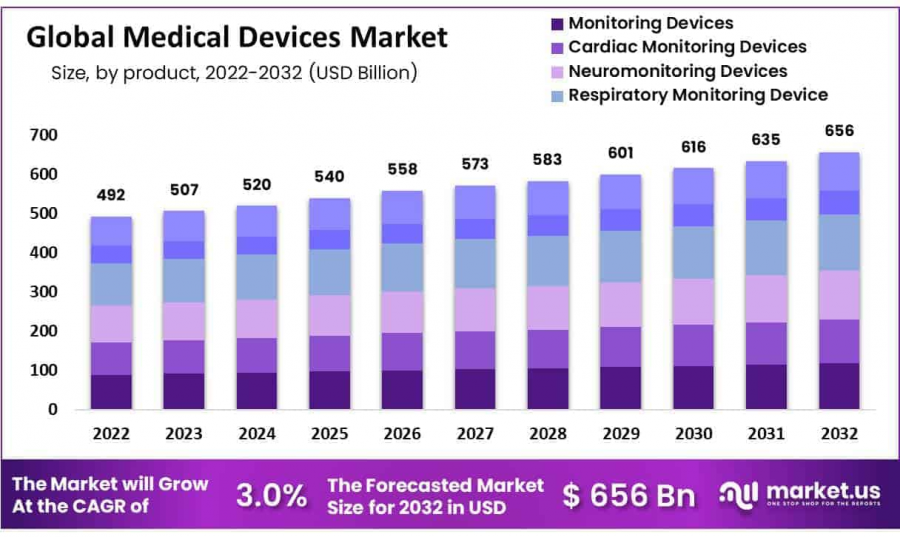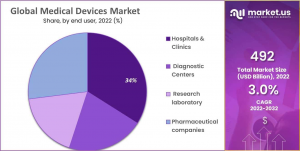
Medical Devices Market Expected to Surpass USD 656 Billion by 2032 at 3% CAGR
Medical Devices Market size is expected to be worth around USD 656 Bn by 2032 at a CAGR of 3% For forecast from 2022 to 2032.
NEW YORK, NY, UNITED STATES, January 22, 2025 /EINPresswire.com/ -- The Global Medical Devices Market Size is expected to reach USD 656 billion by 2032, growing from USD 492 billion in 2022. This growth represents a compound annual growth rate (CAGR) of 3% during the forecast period. Several key factors are driving this expansion, including the aging population, increasing chronic diseases, and advancements in medical technology.
The aging population is contributing to a higher prevalence of chronic diseases, creating a significant demand for medical devices. As people live longer, the need for healthcare solutions to manage age-related conditions increases. This demographic shift underscores the growing necessity for advanced medical technologies to improve patient care and quality of life.
Technological innovations are another crucial driver for market growth. Advancements in artificial intelligence, wearable devices, and the Internet of Things (IoT) are expanding the functionality and efficiency of medical devices. These innovations enhance the overall healthcare experience, making treatments more accessible and personalized, thus accelerating market growth and adoption.
Government initiatives also play a pivotal role in boosting the medical devices sector. Policies such as the Production-Linked Incentive (PLI) Scheme encourage domestic manufacturing, while the National Medical Devices Policy, 2023, supports the development of medical device parks. These measures aim to strengthen the industry, promote self-reliance, and ensure the sector’s continued growth on a global scale.
Rising health awareness and medical tourism are further contributing to market growth. As people become more health-conscious, the demand for medical devices increases. Moreover, medical tourism is expanding as patients seek advanced treatments and devices, particularly in regions with high-quality healthcare systems. This growing trend is enhancing the market outlook for medical devices globally.
Get Sample PDF Report: https://market.us/report/medical-devices-market/request-sample/
Key Takeaway
• The global medical devices market is expected to reach approximately USD 656 billion by 2032, growing at a 3% CAGR from USD 492 billion in 2022.
• Key factors driving market growth include complex surgeries, rising populations, and technological advancements in medical devices, particularly brain monitoring technology.
• The FDA classifies medical devices into three categories—Class I, Class II, and Class III—with varying regulatory controls based on risk levels.
• The In-Vitro Diagnostics (IVD) segment is projected to experience the highest growth, driven by increased demand for chronic and infectious disease diagnostic testing.
• Key market segments include wound management, minimally invasive surgery, cardiovascular devices, orthopedic devices, ophthalmic care, and diabetes management technologies.
• Hospitals and ambulatory surgery centers dominated the medical devices market in 2022, driven by increased healthcare spending and expanding healthcare infrastructure.
• The pandemic temporarily decreased elective procedures but boosted demand for hospital equipment; long-term effects include rising chronic diseases and growth in homecare services.
• North America leads the market, supported by technological innovation, significant healthcare spending, and a large geriatric population, particularly in the United States.
• The medical devices market is highly fragmented, with Medtronic holding a significant share, as many companies focus on R&D and global distribution networks.
Segmentation Analysis
The In-Vitro Diagnostics (IVD) segment is projected to experience substantial growth, driven by the increasing use of real-time diagnostic tools for accurate detection of diseases such as diabetes, cancer, and HIV/AIDS. In 2022, the "others" segment dominated due to high demand for medical supplies like gloves, masks, surgical lights, and fetal monitors. Additionally, rising investment by medical device companies in innovative wound care products, including bioactive treatments, is expected to fuel growth in the wound management segment over the forecast period.
The Minimally Invasive Surgery segment is also set to expand, supported by advancements in surgical robotics and their growing adoption by healthcare providers. Segments such as cardiovascular and orthopedic devices are anticipated to grow rapidly due to the increasing prevalence of cardiac and orthopedic conditions globally. Furthermore, the rising occurrence of retinal and diabetic disorders is likely to drive demand for ophthalmic and diabetes care devices, further contributing to overall market growth in the coming years.
Hospitals and ambulatory surgery centers dominated the global medical devices market in 2022. This growth is largely attributed to increasing healthcare expenditure, improved infrastructure, and favorable reimbursement policies. Many developing countries face shortages in hospital capacity, as highlighted by the WHO. In response, governments in these regions are heavily investing in healthcare infrastructure. For instance, healthcare spending in developing countries is expected to rise significantly in the next five years to address these challenges and improve accessibility.
Overall, the medical devices market is poised for robust growth during the 2022–2032 period. Key drivers include technological advancements, rising disease prevalence, and increased healthcare spending. Segments such as IVD, minimally invasive surgery, and wound management are likely to see significant expansion. Meanwhile, cardiovascular and orthopedic devices will experience accelerated demand due to a growing patient base. Investments in healthcare infrastructure, particularly in developing nations, will further enhance market opportunities and support long-term growth in the industry.
Based on Product
• Monitoring Devices
• Cardiac Monitoring Devices
• Neuromonitoring Devices
• Respiratory Monitoring Device
• Multi-Parameter Monitoring Devices
• Hemodynamic Monitoring Devices
• Fetal and Neonatal Monitoring Devices
• Temperature Monitoring Devices
• Weight Monitoring Devices
• Diagnostic Devices
• Surgical ENT Devices.
• Endoscopes
• Imaging Devices
• Diagnostic Molecular Devices
• Drug Delivery Devices
• Surgical Devices
• Bio Implants and Stimulation Devices
• Treatment Equipment
• Infusion Pumps
• Medical lasers and LASIK surgical machines
• Others
Based on End-User
• Hospitals & Clinics
• Diagnostic Centers
• Research laboratory
• Pharmaceutical companies (Shopping Plazas, Military, Corporate Sectors, Hostels)
Regional Analysis
North America is expected to dominate the medical devices market due to advanced technology, high treatment rates, and government support for early disease detection. The increasing prevalence of chronic diseases, high healthcare spending, and the presence of leading industry players contribute to this market growth. Additionally, Canada’s aging population is anticipated to drive demand for medical devices during the forecast period, as older individuals are more susceptible to chronic conditions requiring medical interventions.
According to United Nations Population Fund data from 2022, about 65% of Canada’s population is between 15 and 64 years old. The same report forecasts that 19% of Canadians will be aged 65 or older by 2022. This demographic shift is expected to have a significant impact on healthcare needs. Older populations are more prone to chronic diseases such as respiratory issues, heart conditions, and orthopedic disorders, further fueling the demand for medical devices to manage and treat these conditions.
The rise in the prevalence of heart disease in the United States is another factor contributing to market growth. According to the American Heart Association’s 2022 data, 6.8% of the U.S. population had heart disease in 2021, which is higher than the overall population. As the demand for effective diagnostics and treatments increases, so does the need for medical devices that can address these issues. This trend is expected to accelerate the market’s growth in the coming years.
The growth in heart surgeries and cardiopulmonary procedures also plays a vital role in expanding the medical devices market. As chronic diseases like stroke and heart disease continue to rise, so does the need for medical devices to assist in treatments such as bypass surgeries. Companies are responding by developing advanced products and pursuing strategic acquisitions and collaborations to maintain their market position, further enhancing the market outlook.
Buy Directly: https://market.us/purchase-report/?report_id=95403
Market Players Analysis
The global medical devices market is highly fragmented due to the presence of numerous regional and local players. Medtronic holds the largest market share, primarily due to its broad product portfolio and strong international reputation. The market's competitive landscape is further intensified by various players striving for growth in both local and global markets. Medtronic’s widespread recognition allows it to maintain a dominant position amidst rising competition.
Companies in the medical device industry are heavily investing in research and development (R&D) to create innovative products and enhance existing ones. R&D efforts are crucial to staying competitive and meeting evolving market demands. As a result, companies continuously strive to improve their technological capabilities and product offerings, ensuring they maintain market relevance and meet the needs of healthcare professionals.
To expand their global presence, market players also focus on building robust distribution networks. This strategy helps businesses increase their market penetration, allowing them to reach new customers and improve sales. Partnerships and strategic product launches play a significant role in strengthening these networks. By diversifying their product lines, companies can further solidify their positions and outpace competitors in a highly competitive marketplace.
The Primary Entities Identified In This Report Are:
• Medtronic Plc
• Abbott Laboratories Inc
• Johnson & Johnson
• Siemens Healthineers AG
• Becton, Dickinson, and Company
• Accord Medical Products Private Limited
• 3M Company
• ARKRAY Healthcare Pvt. Ltd
• Baxter International Inc.
• Agappe Diagnostics Ltd
• Braun Medical Inc.
• BioTelemetry Inc.
• Canon Medical Systems Corporation
• Boston Scientific
• Chart Industries
• Danaher Corporation
*We offer customized market research reports tailored to meet your specific business needs and requirements.
Lawrence John
Prudour
+91 91308 55334
Lawrence@prudour.com
Distribution channels: Healthcare & Pharmaceuticals Industry
Legal Disclaimer:
EIN Presswire provides this news content "as is" without warranty of any kind. We do not accept any responsibility or liability for the accuracy, content, images, videos, licenses, completeness, legality, or reliability of the information contained in this article. If you have any complaints or copyright issues related to this article, kindly contact the author above.
Submit your press release


